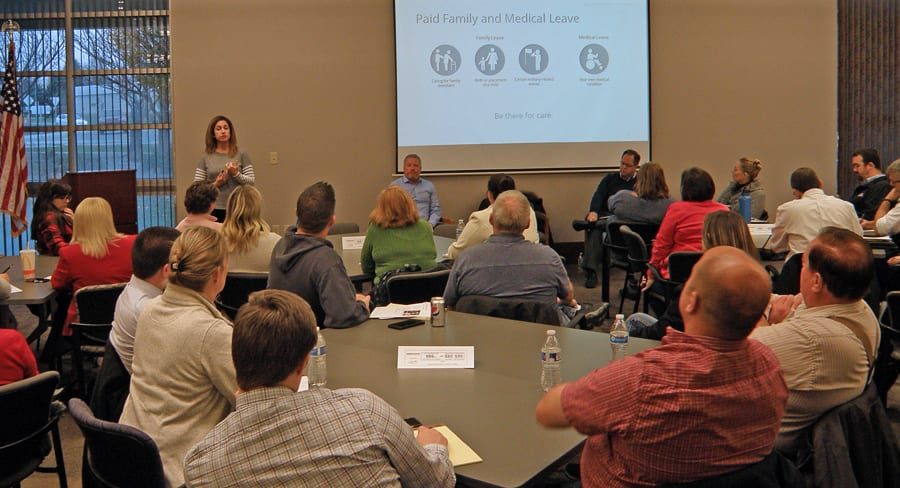
Home » Employers preparing for state’s new paid family, medical leave program
Employers preparing for state’s new paid family, medical leave program

November 14, 2018
In January, employers will begin collecting premiums for the state’s paid family and medical leave insurance program passed into law last year.
Although benefits won’t take effect until Jan. 1, 2020, this statewide benefits program will allow workers to take up to 12 weeks of guaranteed paid time off — 18 weeks in limited special circumstances —and receive partial wage replacement.
The Tri-City Regional Chamber of Commerce hosted an Ask The Experts panel on the issue Nov. 13 to allow attendees to ask questions of George Cicotte, attorney with the Cicotte Law Firm, Silvia Lugo, communications and outreach consultant with the state Employment Security Department, or ESD, and Jerry Marvel, programs director for the Columbia Basin Society for Human Resource Management.
Although programs may vary by state, Washington is the fifth state to get a similar paid family leave program, and the first state to create an insurance program of this kind without a prior state short-term disability program in place, said Clare DeLong, communications manager for the paid family leave program for the ESD.
“All eyes are on Washington right now,” said DeLong. “It’s a considerably high rate of wage replacement and it’s portable between jobs, meaning the leave will follow you if you leave your job.”
Employees are eligible to take up to 12 weeks after the birth, adoption or fostering of a child, if they experience a serious injury or illness, or need to care for a sick or injured relative.
There are also benefits for military families who need to prepare for a family member’s pre- and post-deployment, as well as time for child care issues related to a deployment.
If workers experience multiple events in a given year, they may be eligible to receive up to 16 weeks, or up to 18 weeks, if the employee experiences a serious health condition with a pregnancy that results in incapacity. The wage replacement is generally up to 90 percent of an employee’s weekly wage, with a minimum of $100 per week and a maximum of $1,000 per week. Workers who earn less than the state average would get 90 percent of their income.
An employee must work 820 hours before becoming eligible for the benefits.
The program will be funded by a total premium of 0.4 percent shared by employees and employers. The employer is responsible for about 37 percent of that premium. Employers will be responsible for remitting all premiums collected for paid family and medical leave to the state. Employers also are required to report hours and wages.
For example, the total premium paid for an employee that earns $2,500 in a single pay period will be $10. The employee would have $6.33 deducted from his or her paycheck to cover both family and medical leave. The employer would be responsible for $3.67.
Cicotte, an employee benefits attorney, expects to see those rates increase substantially the following year, when benefits kick in.
“There’s a pretty broad consensus that rates will increase,” Cicotte said. “The assumption is that they came up with an arbitrary and artificially low rate on purpose to pass the law, and it will be adjusted in the future. It can go up starting in 2020.”
Bob Battles, government affairs director and general counsel with the Association of Washington Business, said it was a long and excruciating process of negotiation between labor unions, employers and lawmakers — but ultimately everyone came to a consensus and the law passed with bipartisan support.
“Businesses came together with other parties and I think this is a good compromise,” Battles said. “We tried to get everybody what they wanted.”
Although small businesses with fewer than 50 employees are not exempt from the program, they are exempt from having to pay their portion of the premiums. If they choose to do so, however, they’ll be eligible to receive small business assistance grants to offset wage-related costs associated with employees going on leave.
“They can receive up to $3,000 if a temporary worker has to be hired, or up to $1,000 to offset costs of overtime pay or employee training, they can receive up to 10 grants in a year,” DeLong said.
Employers who wish to offer an employer-funded paid family and medical leave program must apply for a voluntary plan, but benefits offered under the voluntary plan must meet or exceed the benefits of the state plan.
Marvel said what’s needed is education for employees on these new benefits they’re entitled to, but most questions are coming from employers themselves.
“They have questions on how to use their payroll system to remit payment to (Employment Security Department) and how to accurately report wages and hours worked,” Marvel said. “It’s separate from unemployment or tax reporting requirements.”
DeLong said the ESD recently launched an employer toolkit to help employers implement the benefits program and meet the reporting requirements. It includes sample employee communications, a premium calculator and reporting requirements.
“We want to make sure they’re prepared,” DeLong said. “With this we hope to alleviate any anxieties regarding calculations and reporting requirements.”
Employers will need to report employee wages, hours worked and additional information beginning Jan. 1, for reporting in April — and every quarter thereafter.
For more information on paid family and medical leave, visit paidleave.wa.gov/employers.
Local News Labor & Employment
KEYWORDS november 2018





